Accounting Principles: Financial Reporting, Analysis, and Ethics
VerifiedAdded on 2023/06/09
|21
|4472
|292
Report
AI Summary
This report provides a comprehensive analysis of accounting principles and their role in meeting the requirements of various stakeholders. It evaluates the regulatory and ethical constraints within a business context, specifically referencing BAJ Shop. The report explores the role of accounting in informing decision-making to meet business, societal, and stakeholder needs within a complex management system. It includes the computation of financial statements for BAJ Shop, including trading accounts, profit and loss accounts, and financial ratio analysis, with a comparison of financial ratios over multiple years. Additionally, it covers cash budget preparation and the demerits of budgetary planning and control. The report also includes the preparation of partnership trading accounts, profit and loss accounts, balance sheets, income statements, and balance sheets for Creative Kids, offering a thorough overview of accounting practices and financial analysis.
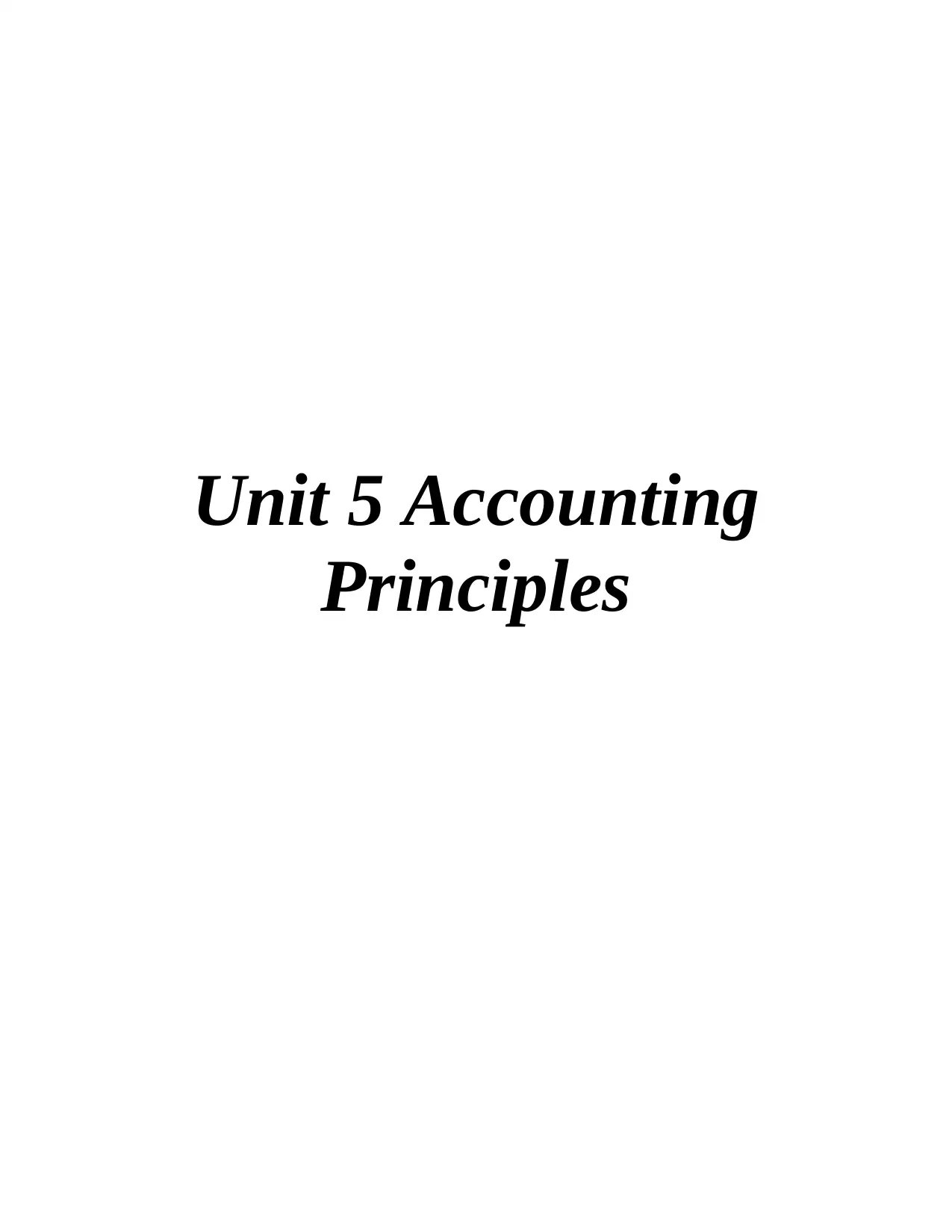
Unit 5 Accounting
Principles
Principles
Paraphrase This Document
Need a fresh take? Get an instant paraphrase of this document with our AI Paraphraser
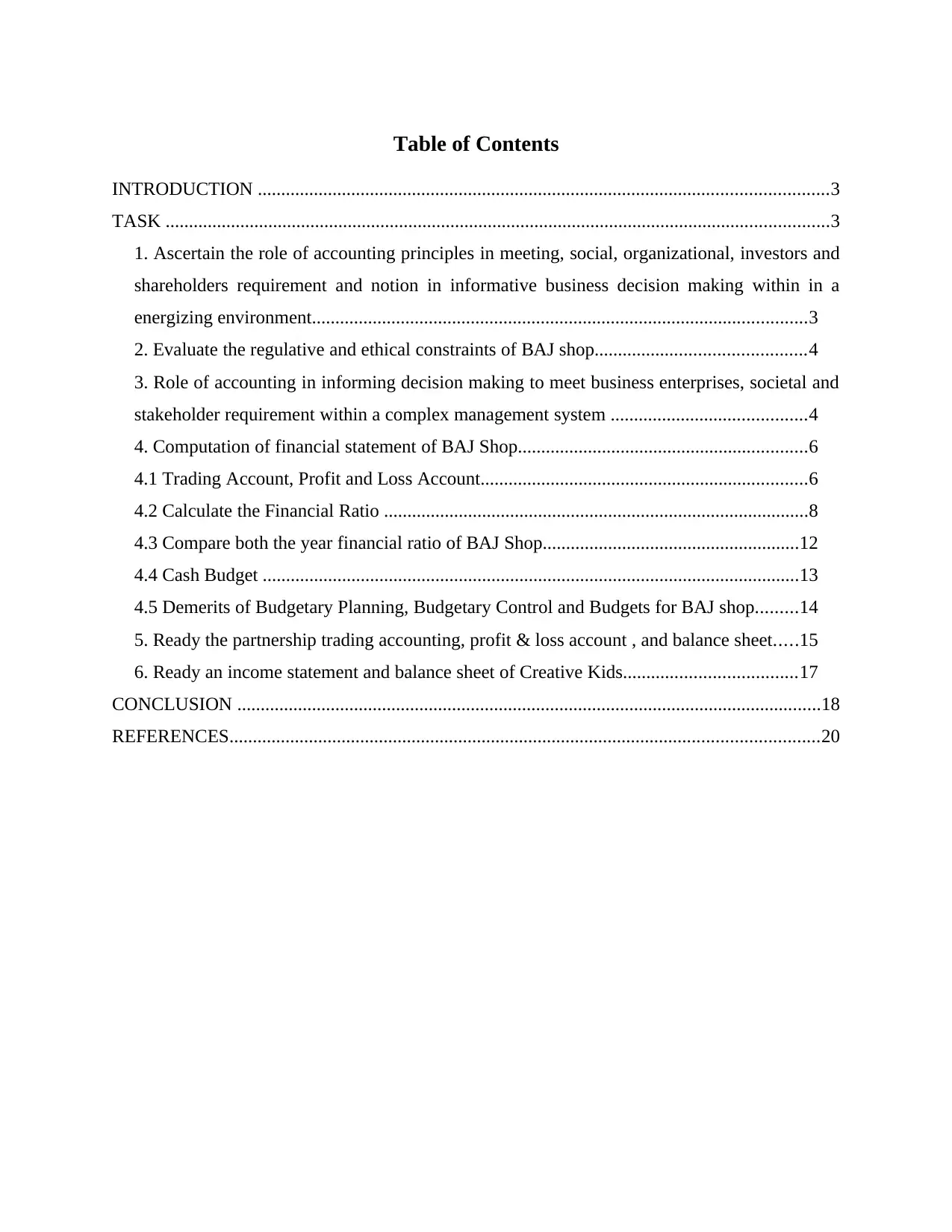
Table of Contents
INTRODUCTION ..........................................................................................................................3
TASK ..............................................................................................................................................3
1. Ascertain the role of accounting principles in meeting, social, organizational, investors and
shareholders requirement and notion in informative business decision making within in a
energizing environment..........................................................................................................3
2. Evaluate the regulative and ethical constraints of BAJ shop.............................................4
3. Role of accounting in informing decision making to meet business enterprises, societal and
stakeholder requirement within a complex management system ..........................................4
4. Computation of financial statement of BAJ Shop..............................................................6
4.1 Trading Account, Profit and Loss Account......................................................................6
4.2 Calculate the Financial Ratio ...........................................................................................8
4.3 Compare both the year financial ratio of BAJ Shop.......................................................12
4.4 Cash Budget ...................................................................................................................13
4.5 Demerits of Budgetary Planning, Budgetary Control and Budgets for BAJ shop.........14
5. Ready the partnership trading accounting, profit & loss account , and balance sheet.....15
6. Ready an income statement and balance sheet of Creative Kids.....................................17
CONCLUSION .............................................................................................................................18
REFERENCES..............................................................................................................................20
INTRODUCTION ..........................................................................................................................3
TASK ..............................................................................................................................................3
1. Ascertain the role of accounting principles in meeting, social, organizational, investors and
shareholders requirement and notion in informative business decision making within in a
energizing environment..........................................................................................................3
2. Evaluate the regulative and ethical constraints of BAJ shop.............................................4
3. Role of accounting in informing decision making to meet business enterprises, societal and
stakeholder requirement within a complex management system ..........................................4
4. Computation of financial statement of BAJ Shop..............................................................6
4.1 Trading Account, Profit and Loss Account......................................................................6
4.2 Calculate the Financial Ratio ...........................................................................................8
4.3 Compare both the year financial ratio of BAJ Shop.......................................................12
4.4 Cash Budget ...................................................................................................................13
4.5 Demerits of Budgetary Planning, Budgetary Control and Budgets for BAJ shop.........14
5. Ready the partnership trading accounting, profit & loss account , and balance sheet.....15
6. Ready an income statement and balance sheet of Creative Kids.....................................17
CONCLUSION .............................................................................................................................18
REFERENCES..............................................................................................................................20
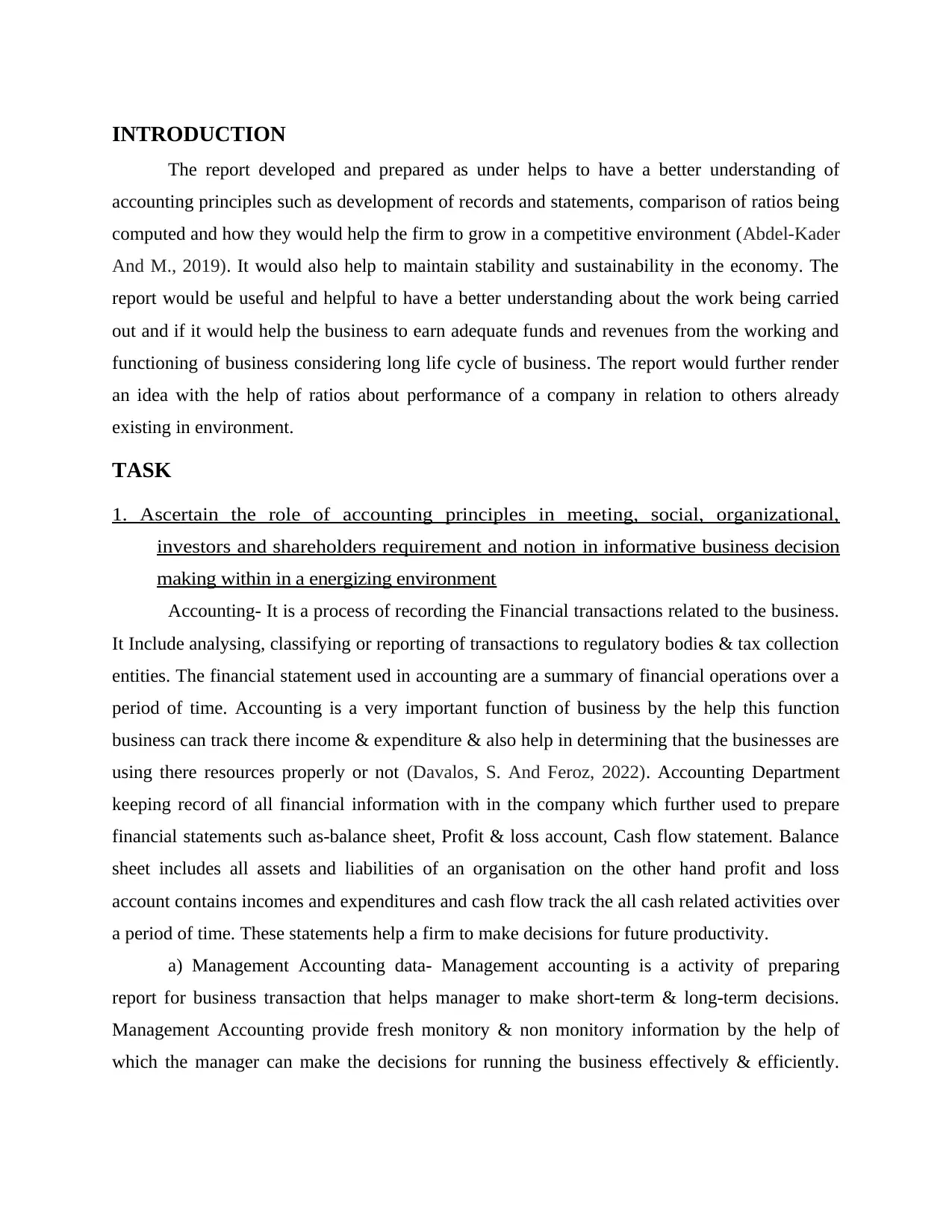
INTRODUCTION
The report developed and prepared as under helps to have a better understanding of
accounting principles such as development of records and statements, comparison of ratios being
computed and how they would help the firm to grow in a competitive environment (Abdel-Kader
And M., 2019). It would also help to maintain stability and sustainability in the economy. The
report would be useful and helpful to have a better understanding about the work being carried
out and if it would help the business to earn adequate funds and revenues from the working and
functioning of business considering long life cycle of business. The report would further render
an idea with the help of ratios about performance of a company in relation to others already
existing in environment.
TASK
1. Ascertain the role of accounting principles in meeting, social, organizational,
investors and shareholders requirement and notion in informative business decision
making within in a energizing environment
Accounting- It is a process of recording the Financial transactions related to the business.
It Include analysing, classifying or reporting of transactions to regulatory bodies & tax collection
entities. The financial statement used in accounting are a summary of financial operations over a
period of time. Accounting is a very important function of business by the help this function
business can track there income & expenditure & also help in determining that the businesses are
using there resources properly or not (Davalos, S. And Feroz, 2022). Accounting Department
keeping record of all financial information with in the company which further used to prepare
financial statements such as-balance sheet, Profit & loss account, Cash flow statement. Balance
sheet includes all assets and liabilities of an organisation on the other hand profit and loss
account contains incomes and expenditures and cash flow track the all cash related activities over
a period of time. These statements help a firm to make decisions for future productivity.
a) Management Accounting data- Management accounting is a activity of preparing
report for business transaction that helps manager to make short-term & long-term decisions.
Management Accounting provide fresh monitory & non monitory information by the help of
which the manager can make the decisions for running the business effectively & efficiently.
The report developed and prepared as under helps to have a better understanding of
accounting principles such as development of records and statements, comparison of ratios being
computed and how they would help the firm to grow in a competitive environment (Abdel-Kader
And M., 2019). It would also help to maintain stability and sustainability in the economy. The
report would be useful and helpful to have a better understanding about the work being carried
out and if it would help the business to earn adequate funds and revenues from the working and
functioning of business considering long life cycle of business. The report would further render
an idea with the help of ratios about performance of a company in relation to others already
existing in environment.
TASK
1. Ascertain the role of accounting principles in meeting, social, organizational,
investors and shareholders requirement and notion in informative business decision
making within in a energizing environment
Accounting- It is a process of recording the Financial transactions related to the business.
It Include analysing, classifying or reporting of transactions to regulatory bodies & tax collection
entities. The financial statement used in accounting are a summary of financial operations over a
period of time. Accounting is a very important function of business by the help this function
business can track there income & expenditure & also help in determining that the businesses are
using there resources properly or not (Davalos, S. And Feroz, 2022). Accounting Department
keeping record of all financial information with in the company which further used to prepare
financial statements such as-balance sheet, Profit & loss account, Cash flow statement. Balance
sheet includes all assets and liabilities of an organisation on the other hand profit and loss
account contains incomes and expenditures and cash flow track the all cash related activities over
a period of time. These statements help a firm to make decisions for future productivity.
a) Management Accounting data- Management accounting is a activity of preparing
report for business transaction that helps manager to make short-term & long-term decisions.
Management Accounting provide fresh monitory & non monitory information by the help of
which the manager can make the decisions for running the business effectively & efficiently.
⊘ This is a preview!⊘
Do you want full access?
Subscribe today to unlock all pages.

Trusted by 1+ million students worldwide
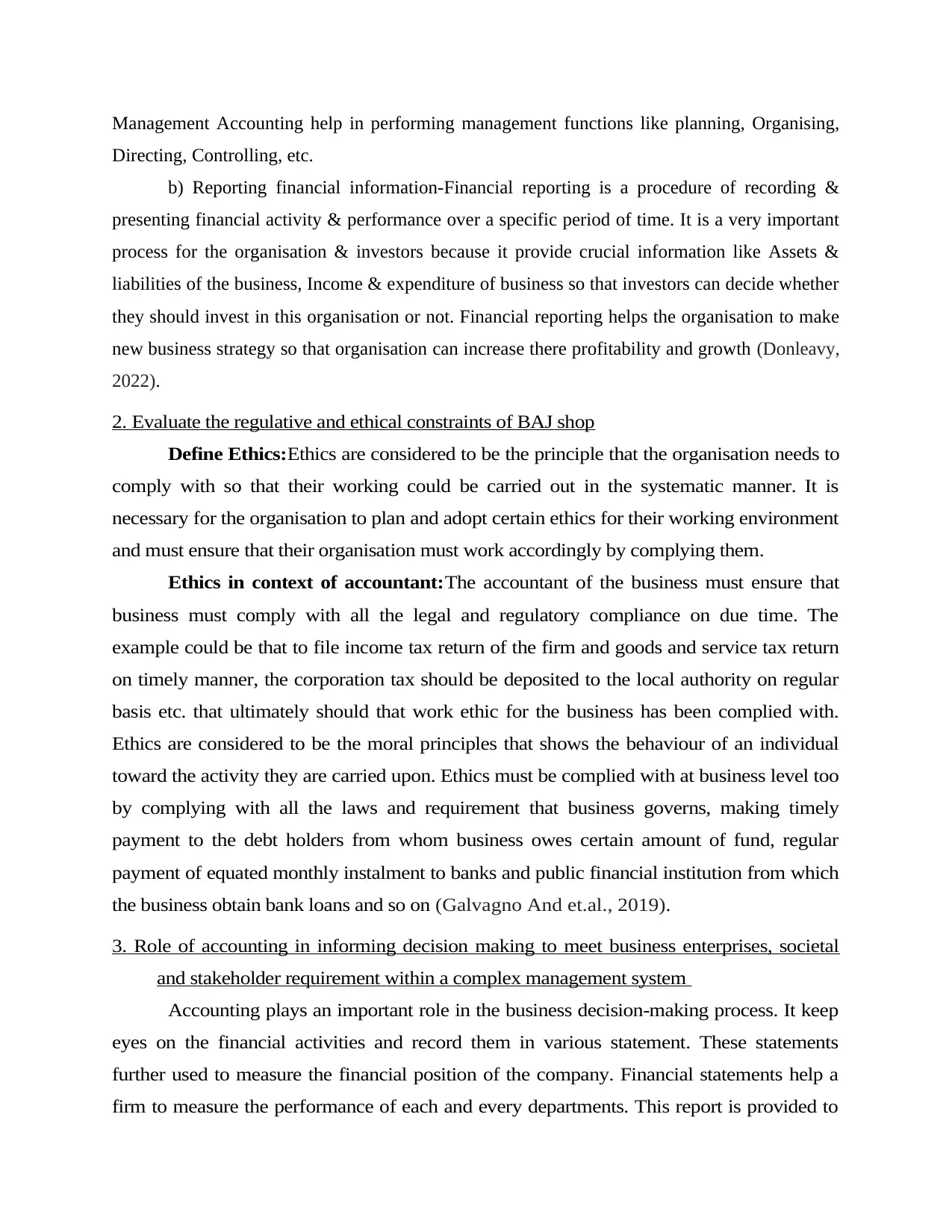
Management Accounting help in performing management functions like planning, Organising,
Directing, Controlling, etc.
b) Reporting financial information-Financial reporting is a procedure of recording &
presenting financial activity & performance over a specific period of time. It is a very important
process for the organisation & investors because it provide crucial information like Assets &
liabilities of the business, Income & expenditure of business so that investors can decide whether
they should invest in this organisation or not. Financial reporting helps the organisation to make
new business strategy so that organisation can increase there profitability and growth (Donleavy,
2022).
2. Evaluate the regulative and ethical constraints of BAJ shop
Define Ethics:Ethics are considered to be the principle that the organisation needs to
comply with so that their working could be carried out in the systematic manner. It is
necessary for the organisation to plan and adopt certain ethics for their working environment
and must ensure that their organisation must work accordingly by complying them.
Ethics in context of accountant:The accountant of the business must ensure that
business must comply with all the legal and regulatory compliance on due time. The
example could be that to file income tax return of the firm and goods and service tax return
on timely manner, the corporation tax should be deposited to the local authority on regular
basis etc. that ultimately should that work ethic for the business has been complied with.
Ethics are considered to be the moral principles that shows the behaviour of an individual
toward the activity they are carried upon. Ethics must be complied with at business level too
by complying with all the laws and requirement that business governs, making timely
payment to the debt holders from whom business owes certain amount of fund, regular
payment of equated monthly instalment to banks and public financial institution from which
the business obtain bank loans and so on (Galvagno And et.al., 2019).
3. Role of accounting in informing decision making to meet business enterprises, societal
and stakeholder requirement within a complex management system
Accounting plays an important role in the business decision-making process. It keep
eyes on the financial activities and record them in various statement. These statements
further used to measure the financial position of the company. Financial statements help a
firm to measure the performance of each and every departments. This report is provided to
Directing, Controlling, etc.
b) Reporting financial information-Financial reporting is a procedure of recording &
presenting financial activity & performance over a specific period of time. It is a very important
process for the organisation & investors because it provide crucial information like Assets &
liabilities of the business, Income & expenditure of business so that investors can decide whether
they should invest in this organisation or not. Financial reporting helps the organisation to make
new business strategy so that organisation can increase there profitability and growth (Donleavy,
2022).
2. Evaluate the regulative and ethical constraints of BAJ shop
Define Ethics:Ethics are considered to be the principle that the organisation needs to
comply with so that their working could be carried out in the systematic manner. It is
necessary for the organisation to plan and adopt certain ethics for their working environment
and must ensure that their organisation must work accordingly by complying them.
Ethics in context of accountant:The accountant of the business must ensure that
business must comply with all the legal and regulatory compliance on due time. The
example could be that to file income tax return of the firm and goods and service tax return
on timely manner, the corporation tax should be deposited to the local authority on regular
basis etc. that ultimately should that work ethic for the business has been complied with.
Ethics are considered to be the moral principles that shows the behaviour of an individual
toward the activity they are carried upon. Ethics must be complied with at business level too
by complying with all the laws and requirement that business governs, making timely
payment to the debt holders from whom business owes certain amount of fund, regular
payment of equated monthly instalment to banks and public financial institution from which
the business obtain bank loans and so on (Galvagno And et.al., 2019).
3. Role of accounting in informing decision making to meet business enterprises, societal
and stakeholder requirement within a complex management system
Accounting plays an important role in the business decision-making process. It keep
eyes on the financial activities and record them in various statement. These statements
further used to measure the financial position of the company. Financial statements help a
firm to measure the performance of each and every departments. This report is provided to
Paraphrase This Document
Need a fresh take? Get an instant paraphrase of this document with our AI Paraphraser
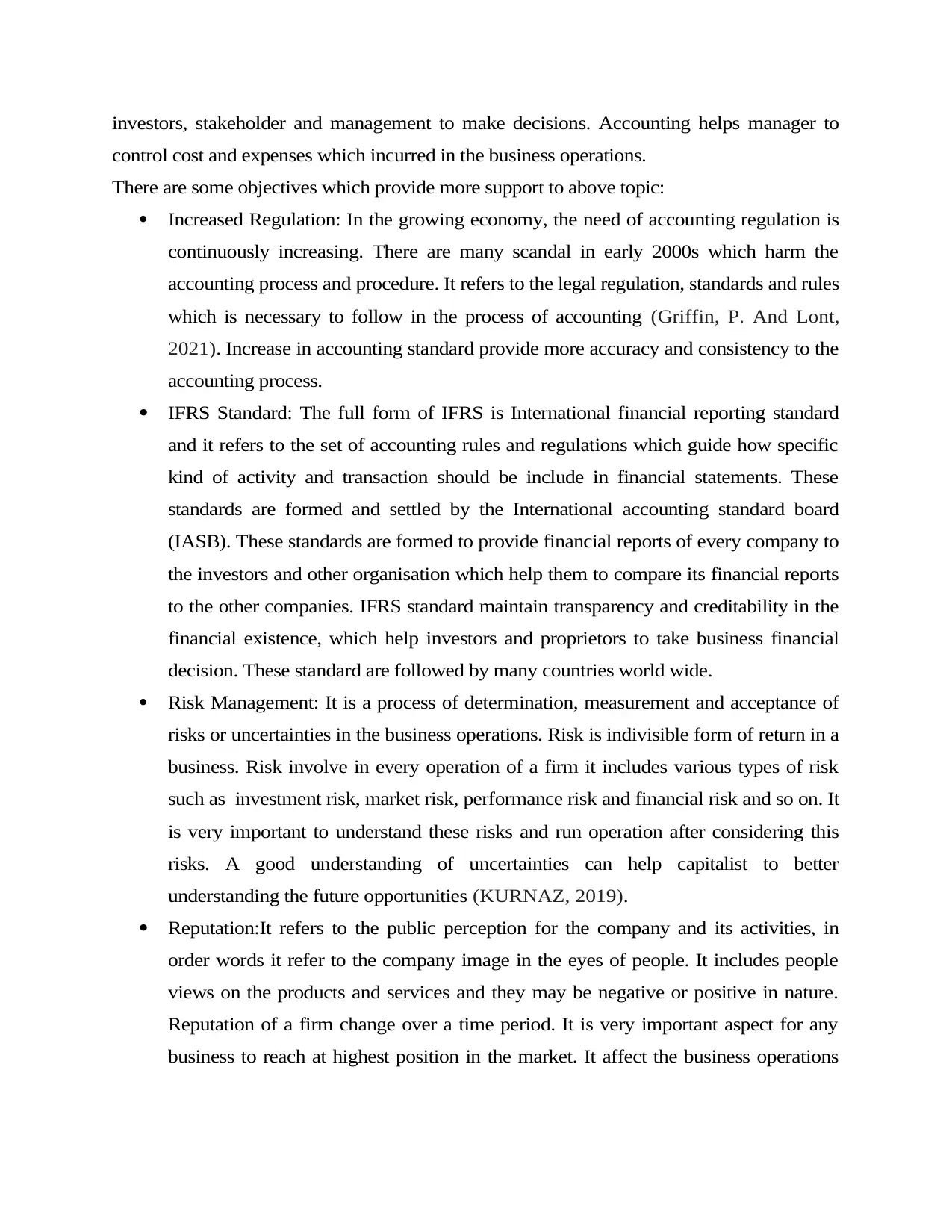
investors, stakeholder and management to make decisions. Accounting helps manager to
control cost and expenses which incurred in the business operations.
There are some objectives which provide more support to above topic:
Increased Regulation: In the growing economy, the need of accounting regulation is
continuously increasing. There are many scandal in early 2000s which harm the
accounting process and procedure. It refers to the legal regulation, standards and rules
which is necessary to follow in the process of accounting (Griffin, P. And Lont,
2021). Increase in accounting standard provide more accuracy and consistency to the
accounting process.
IFRS Standard: The full form of IFRS is International financial reporting standard
and it refers to the set of accounting rules and regulations which guide how specific
kind of activity and transaction should be include in financial statements. These
standards are formed and settled by the International accounting standard board
(IASB). These standards are formed to provide financial reports of every company to
the investors and other organisation which help them to compare its financial reports
to the other companies. IFRS standard maintain transparency and creditability in the
financial existence, which help investors and proprietors to take business financial
decision. These standard are followed by many countries world wide.
Risk Management: It is a process of determination, measurement and acceptance of
risks or uncertainties in the business operations. Risk is indivisible form of return in a
business. Risk involve in every operation of a firm it includes various types of risk
such as investment risk, market risk, performance risk and financial risk and so on. It
is very important to understand these risks and run operation after considering this
risks. A good understanding of uncertainties can help capitalist to better
understanding the future opportunities (KURNAZ, 2019).
Reputation:It refers to the public perception for the company and its activities, in
order words it refer to the company image in the eyes of people. It includes people
views on the products and services and they may be negative or positive in nature.
Reputation of a firm change over a time period. It is very important aspect for any
business to reach at highest position in the market. It affect the business operations
control cost and expenses which incurred in the business operations.
There are some objectives which provide more support to above topic:
Increased Regulation: In the growing economy, the need of accounting regulation is
continuously increasing. There are many scandal in early 2000s which harm the
accounting process and procedure. It refers to the legal regulation, standards and rules
which is necessary to follow in the process of accounting (Griffin, P. And Lont,
2021). Increase in accounting standard provide more accuracy and consistency to the
accounting process.
IFRS Standard: The full form of IFRS is International financial reporting standard
and it refers to the set of accounting rules and regulations which guide how specific
kind of activity and transaction should be include in financial statements. These
standards are formed and settled by the International accounting standard board
(IASB). These standards are formed to provide financial reports of every company to
the investors and other organisation which help them to compare its financial reports
to the other companies. IFRS standard maintain transparency and creditability in the
financial existence, which help investors and proprietors to take business financial
decision. These standard are followed by many countries world wide.
Risk Management: It is a process of determination, measurement and acceptance of
risks or uncertainties in the business operations. Risk is indivisible form of return in a
business. Risk involve in every operation of a firm it includes various types of risk
such as investment risk, market risk, performance risk and financial risk and so on. It
is very important to understand these risks and run operation after considering this
risks. A good understanding of uncertainties can help capitalist to better
understanding the future opportunities (KURNAZ, 2019).
Reputation:It refers to the public perception for the company and its activities, in
order words it refer to the company image in the eyes of people. It includes people
views on the products and services and they may be negative or positive in nature.
Reputation of a firm change over a time period. It is very important aspect for any
business to reach at highest position in the market. It affect the business operations
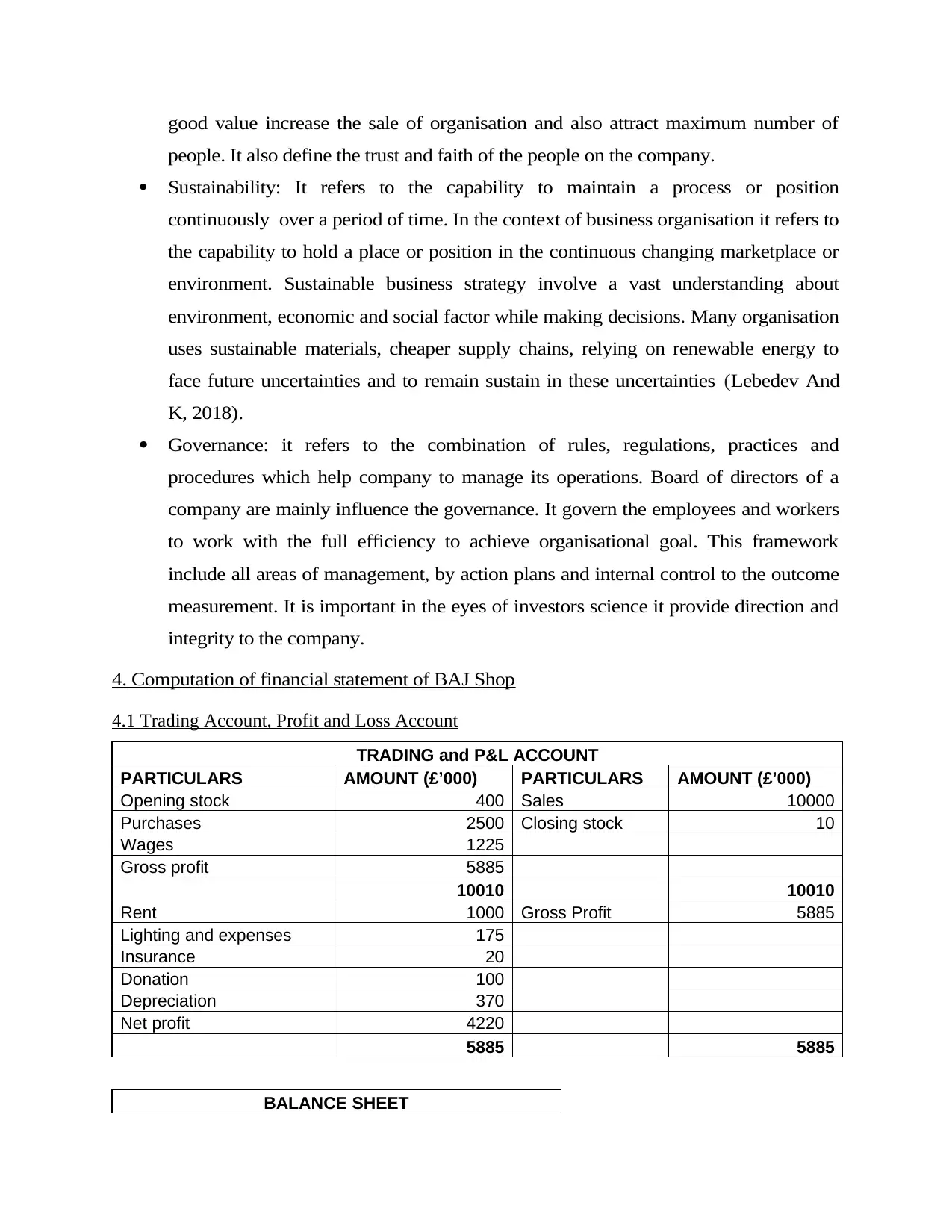
good value increase the sale of organisation and also attract maximum number of
people. It also define the trust and faith of the people on the company.
Sustainability: It refers to the capability to maintain a process or position
continuously over a period of time. In the context of business organisation it refers to
the capability to hold a place or position in the continuous changing marketplace or
environment. Sustainable business strategy involve a vast understanding about
environment, economic and social factor while making decisions. Many organisation
uses sustainable materials, cheaper supply chains, relying on renewable energy to
face future uncertainties and to remain sustain in these uncertainties (Lebedev And
K, 2018).
Governance: it refers to the combination of rules, regulations, practices and
procedures which help company to manage its operations. Board of directors of a
company are mainly influence the governance. It govern the employees and workers
to work with the full efficiency to achieve organisational goal. This framework
include all areas of management, by action plans and internal control to the outcome
measurement. It is important in the eyes of investors science it provide direction and
integrity to the company.
4. Computation of financial statement of BAJ Shop
4.1 Trading Account, Profit and Loss Account
TRADING and P&L ACCOUNT
PARTICULARS AMOUNT (£’000) PARTICULARS AMOUNT (£’000)
Opening stock 400 Sales 10000
Purchases 2500 Closing stock 10
Wages 1225
Gross profit 5885
10010 10010
Rent 1000 Gross Profit 5885
Lighting and expenses 175
Insurance 20
Donation 100
Depreciation 370
Net profit 4220
5885 5885
BALANCE SHEET
people. It also define the trust and faith of the people on the company.
Sustainability: It refers to the capability to maintain a process or position
continuously over a period of time. In the context of business organisation it refers to
the capability to hold a place or position in the continuous changing marketplace or
environment. Sustainable business strategy involve a vast understanding about
environment, economic and social factor while making decisions. Many organisation
uses sustainable materials, cheaper supply chains, relying on renewable energy to
face future uncertainties and to remain sustain in these uncertainties (Lebedev And
K, 2018).
Governance: it refers to the combination of rules, regulations, practices and
procedures which help company to manage its operations. Board of directors of a
company are mainly influence the governance. It govern the employees and workers
to work with the full efficiency to achieve organisational goal. This framework
include all areas of management, by action plans and internal control to the outcome
measurement. It is important in the eyes of investors science it provide direction and
integrity to the company.
4. Computation of financial statement of BAJ Shop
4.1 Trading Account, Profit and Loss Account
TRADING and P&L ACCOUNT
PARTICULARS AMOUNT (£’000) PARTICULARS AMOUNT (£’000)
Opening stock 400 Sales 10000
Purchases 2500 Closing stock 10
Wages 1225
Gross profit 5885
10010 10010
Rent 1000 Gross Profit 5885
Lighting and expenses 175
Insurance 20
Donation 100
Depreciation 370
Net profit 4220
5885 5885
BALANCE SHEET
⊘ This is a preview!⊘
Do you want full access?
Subscribe today to unlock all pages.

Trusted by 1+ million students worldwide
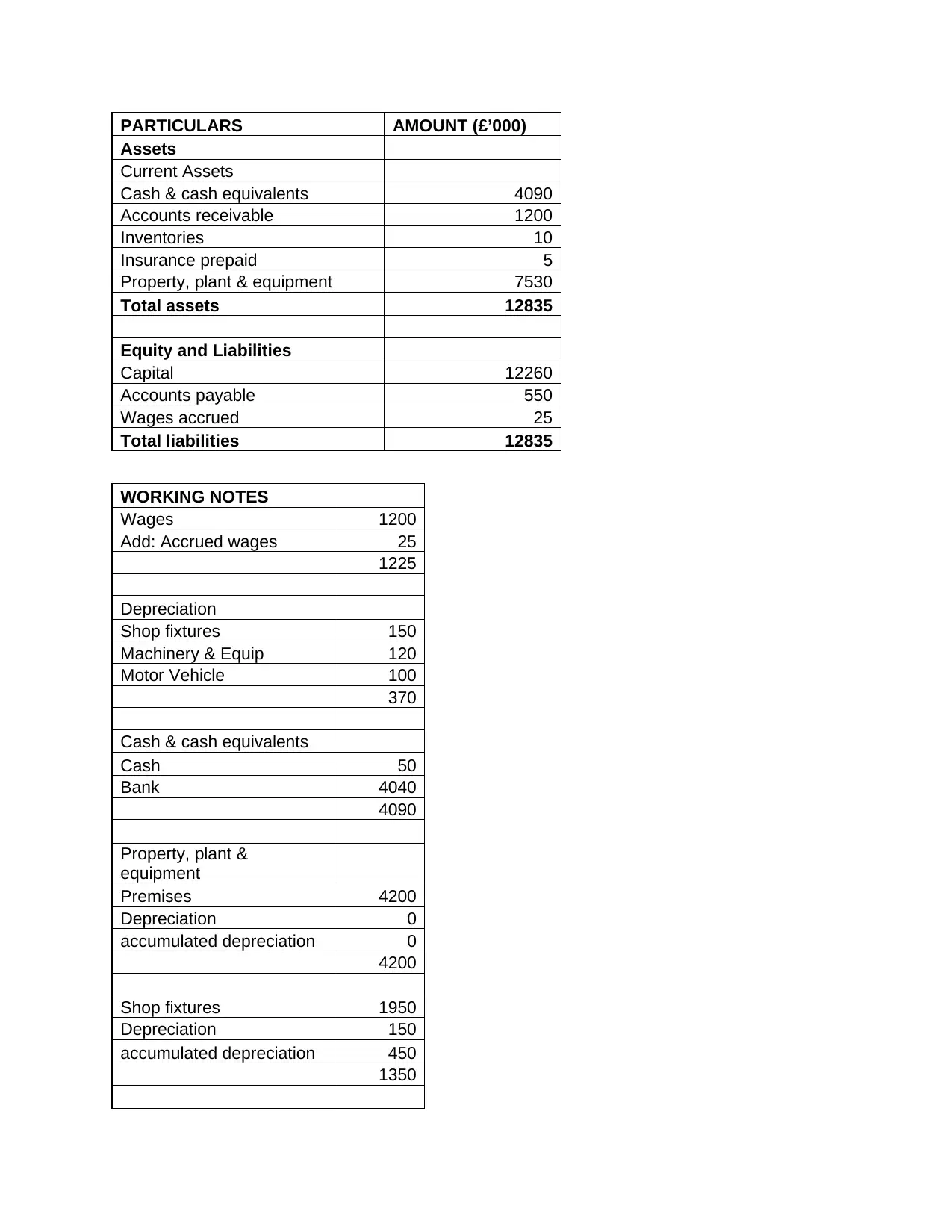
PARTICULARS AMOUNT (£’000)
Assets
Current Assets
Cash & cash equivalents 4090
Accounts receivable 1200
Inventories 10
Insurance prepaid 5
Property, plant & equipment 7530
Total assets 12835
Equity and Liabilities
Capital 12260
Accounts payable 550
Wages accrued 25
Total liabilities 12835
WORKING NOTES
Wages 1200
Add: Accrued wages 25
1225
Depreciation
Shop fixtures 150
Machinery & Equip 120
Motor Vehicle 100
370
Cash & cash equivalents
Cash 50
Bank 4040
4090
Property, plant &
equipment
Premises 4200
Depreciation 0
accumulated depreciation 0
4200
Shop fixtures 1950
Depreciation 150
accumulated depreciation 450
1350
Assets
Current Assets
Cash & cash equivalents 4090
Accounts receivable 1200
Inventories 10
Insurance prepaid 5
Property, plant & equipment 7530
Total assets 12835
Equity and Liabilities
Capital 12260
Accounts payable 550
Wages accrued 25
Total liabilities 12835
WORKING NOTES
Wages 1200
Add: Accrued wages 25
1225
Depreciation
Shop fixtures 150
Machinery & Equip 120
Motor Vehicle 100
370
Cash & cash equivalents
Cash 50
Bank 4040
4090
Property, plant &
equipment
Premises 4200
Depreciation 0
accumulated depreciation 0
4200
Shop fixtures 1950
Depreciation 150
accumulated depreciation 450
1350
Paraphrase This Document
Need a fresh take? Get an instant paraphrase of this document with our AI Paraphraser
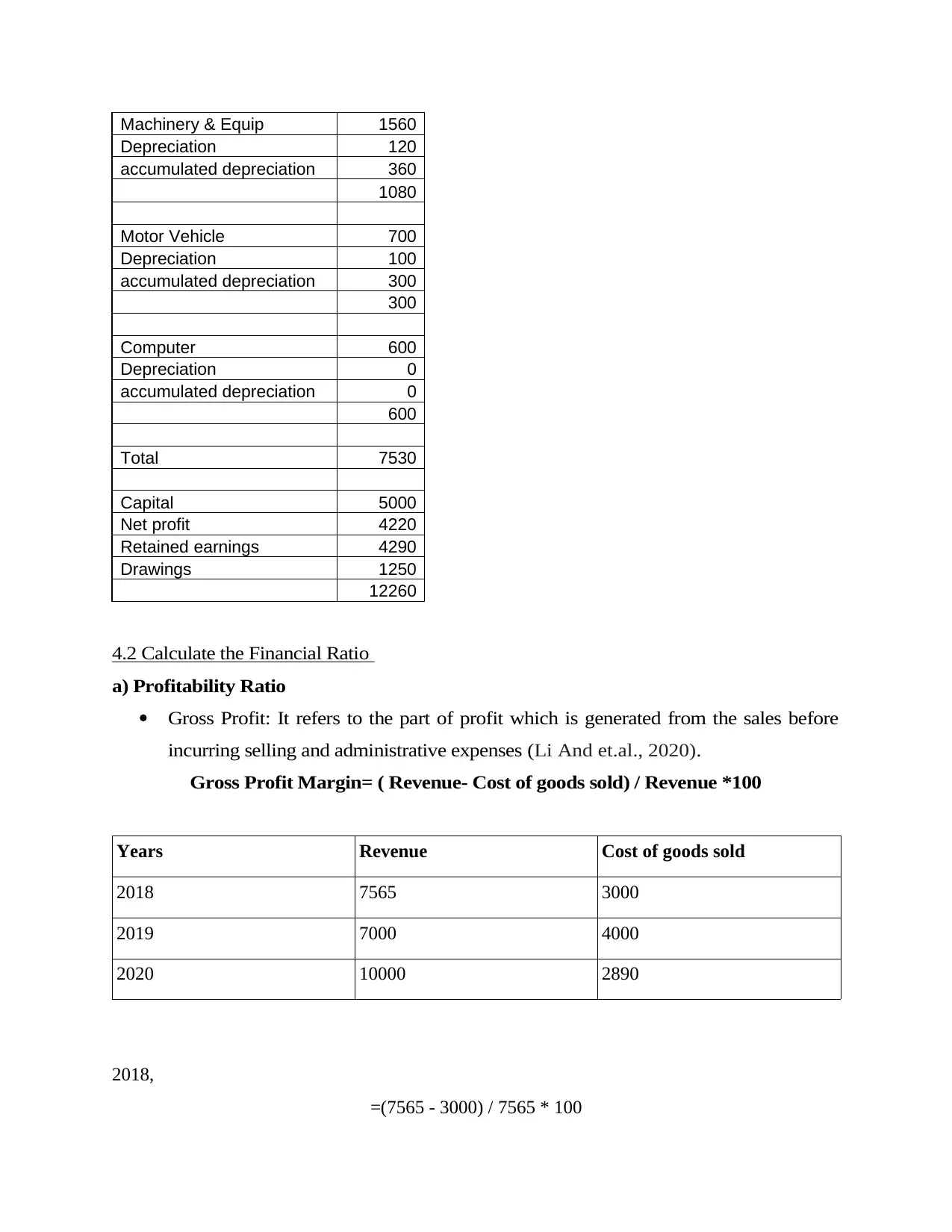
Machinery & Equip 1560
Depreciation 120
accumulated depreciation 360
1080
Motor Vehicle 700
Depreciation 100
accumulated depreciation 300
300
Computer 600
Depreciation 0
accumulated depreciation 0
600
Total 7530
Capital 5000
Net profit 4220
Retained earnings 4290
Drawings 1250
12260
4.2 Calculate the Financial Ratio
a) Profitability Ratio
Gross Profit: It refers to the part of profit which is generated from the sales before
incurring selling and administrative expenses (Li And et.al., 2020).
Gross Profit Margin= ( Revenue- Cost of goods sold) / Revenue *100
Years Revenue Cost of goods sold
2018 7565 3000
2019 7000 4000
2020 10000 2890
2018,
=(7565 - 3000) / 7565 * 100
Depreciation 120
accumulated depreciation 360
1080
Motor Vehicle 700
Depreciation 100
accumulated depreciation 300
300
Computer 600
Depreciation 0
accumulated depreciation 0
600
Total 7530
Capital 5000
Net profit 4220
Retained earnings 4290
Drawings 1250
12260
4.2 Calculate the Financial Ratio
a) Profitability Ratio
Gross Profit: It refers to the part of profit which is generated from the sales before
incurring selling and administrative expenses (Li And et.al., 2020).
Gross Profit Margin= ( Revenue- Cost of goods sold) / Revenue *100
Years Revenue Cost of goods sold
2018 7565 3000
2019 7000 4000
2020 10000 2890
2018,
=(7565 - 3000) / 7565 * 100
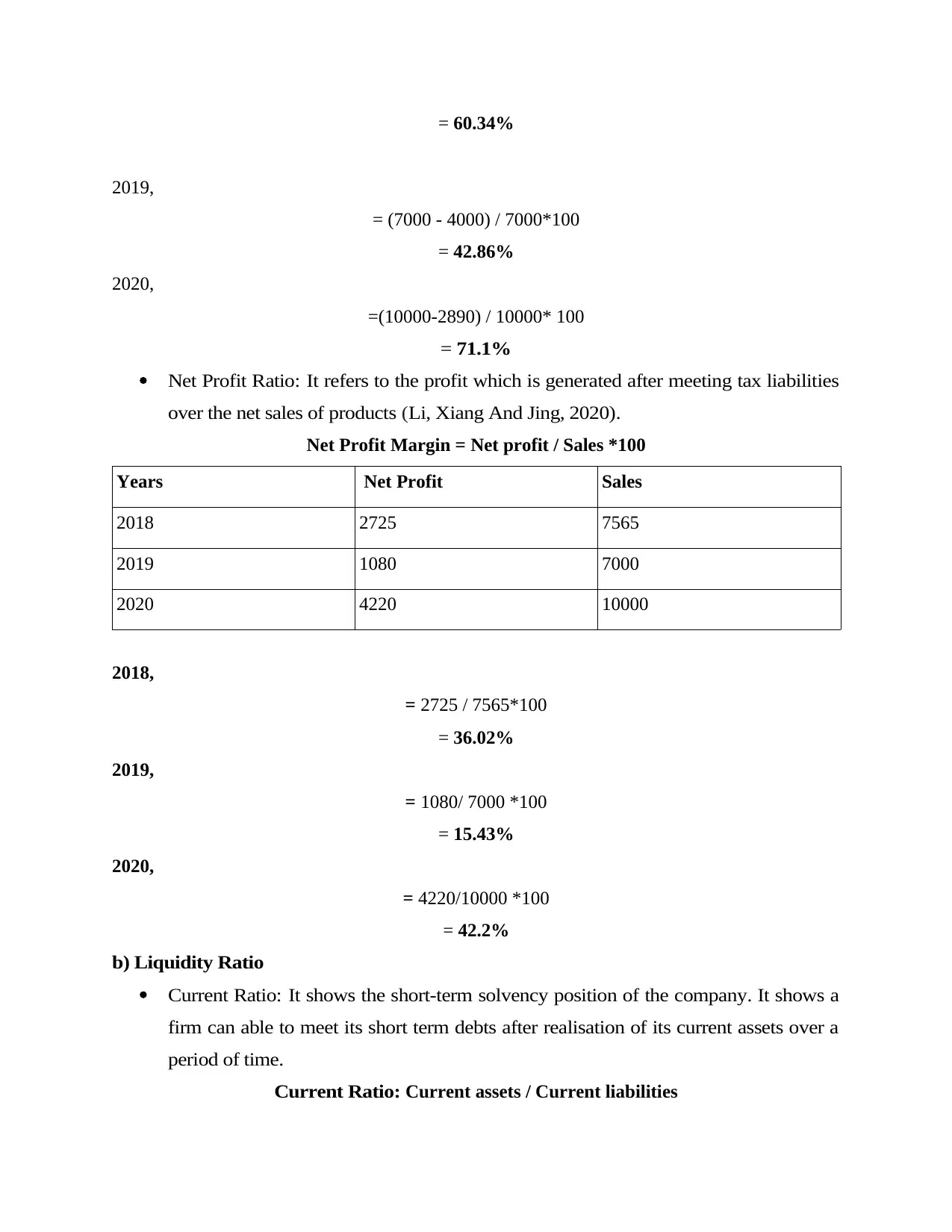
= 60.34%
2019,
= (7000 - 4000) / 7000*100
= 42.86%
2020,
=(10000-2890) / 10000* 100
= 71.1%
Net Profit Ratio: It refers to the profit which is generated after meeting tax liabilities
over the net sales of products (Li, Xiang And Jing, 2020).
Net Profit Margin = Net profit / Sales *100
Years Net Profit Sales
2018 2725 7565
2019 1080 7000
2020 4220 10000
2018,
= 2725 / 7565*100
= 36.02%
2019,
= 1080/ 7000 *100
= 15.43%
2020,
= 4220/10000 *100
= 42.2%
b) Liquidity Ratio
Current Ratio: It shows the short-term solvency position of the company. It shows a
firm can able to meet its short term debts after realisation of its current assets over a
period of time.
Current Ratio: Current assets / Current liabilities
2019,
= (7000 - 4000) / 7000*100
= 42.86%
2020,
=(10000-2890) / 10000* 100
= 71.1%
Net Profit Ratio: It refers to the profit which is generated after meeting tax liabilities
over the net sales of products (Li, Xiang And Jing, 2020).
Net Profit Margin = Net profit / Sales *100
Years Net Profit Sales
2018 2725 7565
2019 1080 7000
2020 4220 10000
2018,
= 2725 / 7565*100
= 36.02%
2019,
= 1080/ 7000 *100
= 15.43%
2020,
= 4220/10000 *100
= 42.2%
b) Liquidity Ratio
Current Ratio: It shows the short-term solvency position of the company. It shows a
firm can able to meet its short term debts after realisation of its current assets over a
period of time.
Current Ratio: Current assets / Current liabilities
⊘ This is a preview!⊘
Do you want full access?
Subscribe today to unlock all pages.

Trusted by 1+ million students worldwide
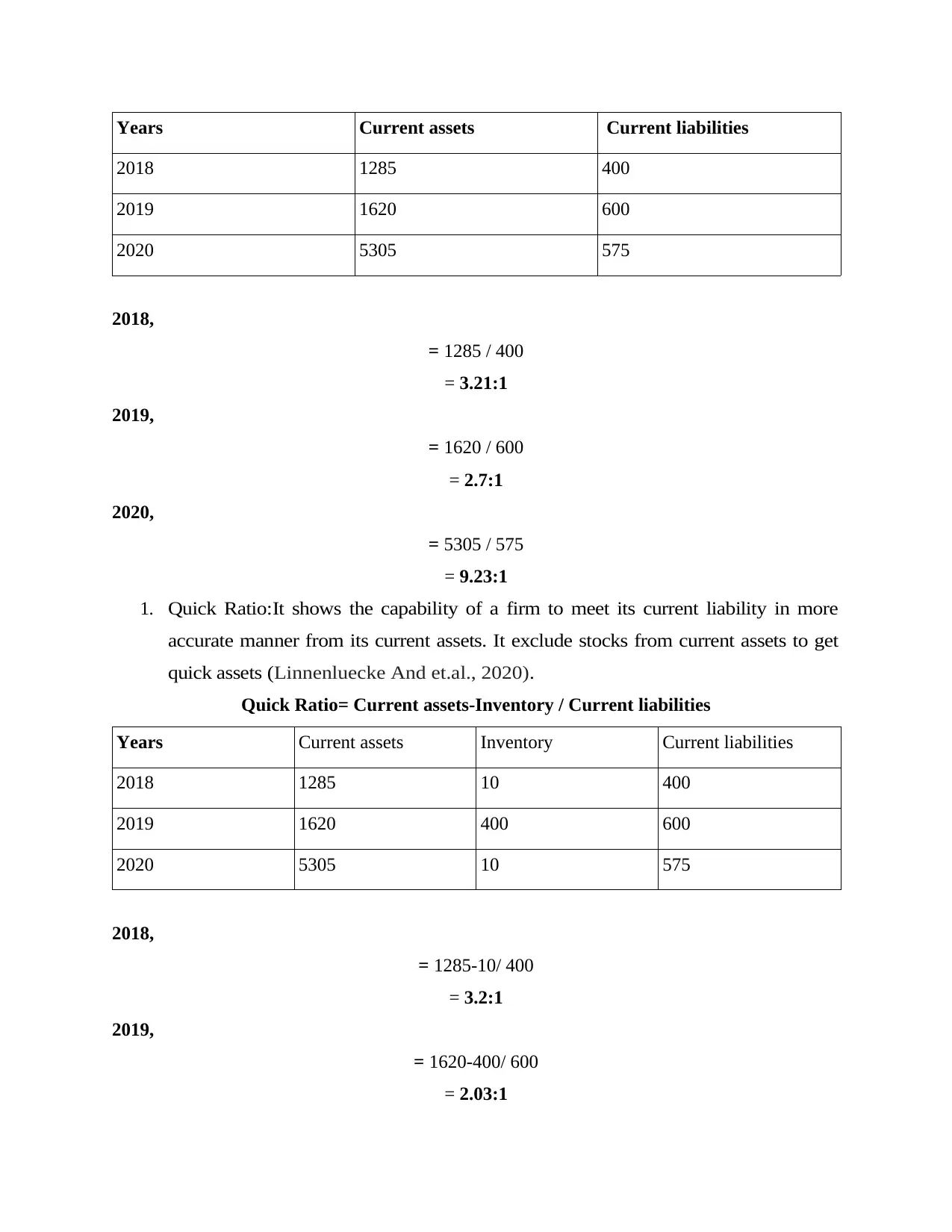
Years Current assets Current liabilities
2018 1285 400
2019 1620 600
2020 5305 575
2018,
= 1285 / 400
= 3.21:1
2019,
= 1620 / 600
= 2.7:1
2020,
= 5305 / 575
= 9.23:1
1. Quick Ratio:It shows the capability of a firm to meet its current liability in more
accurate manner from its current assets. It exclude stocks from current assets to get
quick assets (Linnenluecke And et.al., 2020).
Quick Ratio= Current assets-Inventory / Current liabilities
Years Current assets Inventory Current liabilities
2018 1285 10 400
2019 1620 400 600
2020 5305 10 575
2018,
= 1285-10/ 400
= 3.2:1
2019,
= 1620-400/ 600
= 2.03:1
2018 1285 400
2019 1620 600
2020 5305 575
2018,
= 1285 / 400
= 3.21:1
2019,
= 1620 / 600
= 2.7:1
2020,
= 5305 / 575
= 9.23:1
1. Quick Ratio:It shows the capability of a firm to meet its current liability in more
accurate manner from its current assets. It exclude stocks from current assets to get
quick assets (Linnenluecke And et.al., 2020).
Quick Ratio= Current assets-Inventory / Current liabilities
Years Current assets Inventory Current liabilities
2018 1285 10 400
2019 1620 400 600
2020 5305 10 575
2018,
= 1285-10/ 400
= 3.2:1
2019,
= 1620-400/ 600
= 2.03:1
Paraphrase This Document
Need a fresh take? Get an instant paraphrase of this document with our AI Paraphraser
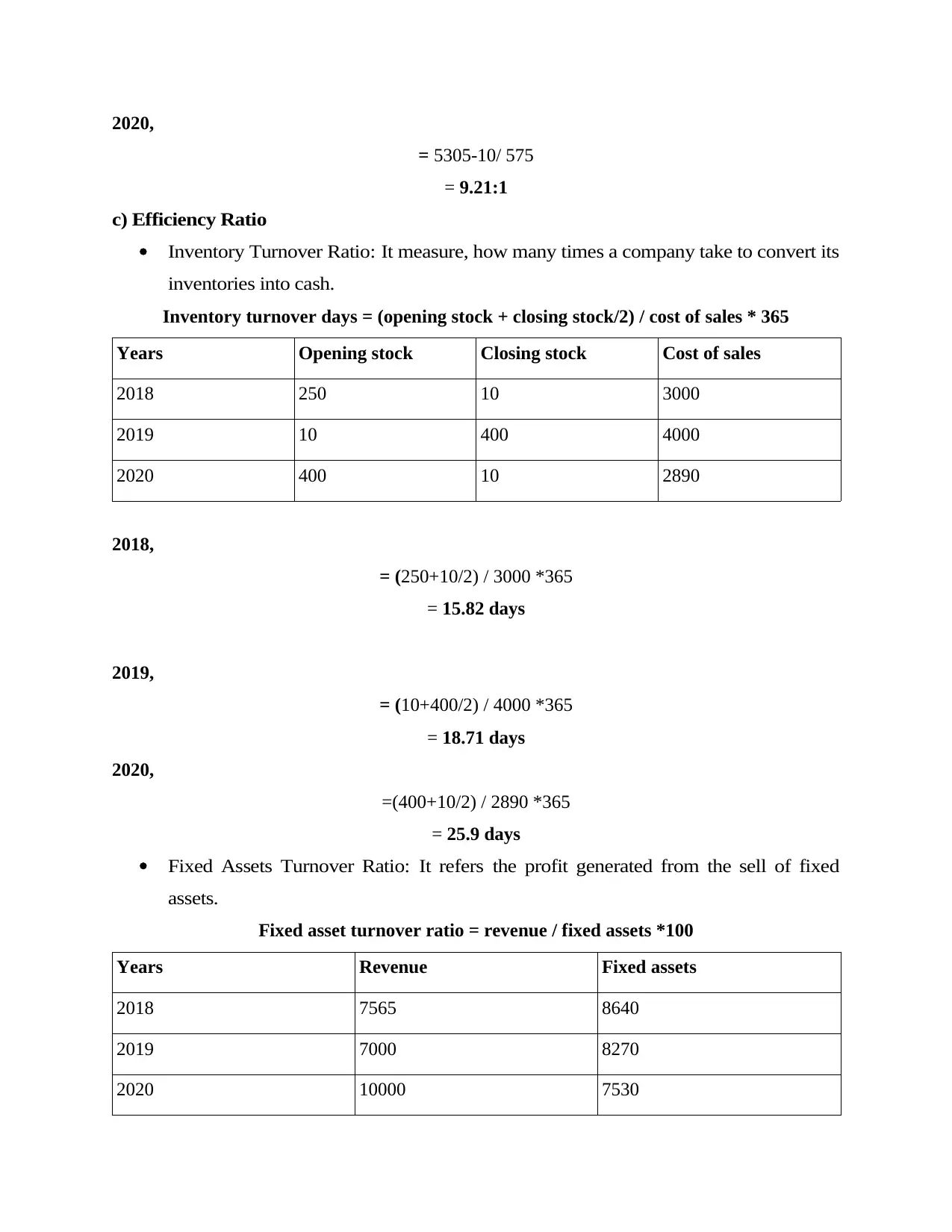
2020,
= 5305-10/ 575
= 9.21:1
c) Efficiency Ratio
Inventory Turnover Ratio: It measure, how many times a company take to convert its
inventories into cash.
Inventory turnover days = (opening stock + closing stock/2) / cost of sales * 365
Years Opening stock Closing stock Cost of sales
2018 250 10 3000
2019 10 400 4000
2020 400 10 2890
2018,
= (250+10/2) / 3000 *365
= 15.82 days
2019,
= (10+400/2) / 4000 *365
= 18.71 days
2020,
=(400+10/2) / 2890 *365
= 25.9 days
Fixed Assets Turnover Ratio: It refers the profit generated from the sell of fixed
assets.
Fixed asset turnover ratio = revenue / fixed assets *100
Years Revenue Fixed assets
2018 7565 8640
2019 7000 8270
2020 10000 7530
= 5305-10/ 575
= 9.21:1
c) Efficiency Ratio
Inventory Turnover Ratio: It measure, how many times a company take to convert its
inventories into cash.
Inventory turnover days = (opening stock + closing stock/2) / cost of sales * 365
Years Opening stock Closing stock Cost of sales
2018 250 10 3000
2019 10 400 4000
2020 400 10 2890
2018,
= (250+10/2) / 3000 *365
= 15.82 days
2019,
= (10+400/2) / 4000 *365
= 18.71 days
2020,
=(400+10/2) / 2890 *365
= 25.9 days
Fixed Assets Turnover Ratio: It refers the profit generated from the sell of fixed
assets.
Fixed asset turnover ratio = revenue / fixed assets *100
Years Revenue Fixed assets
2018 7565 8640
2019 7000 8270
2020 10000 7530
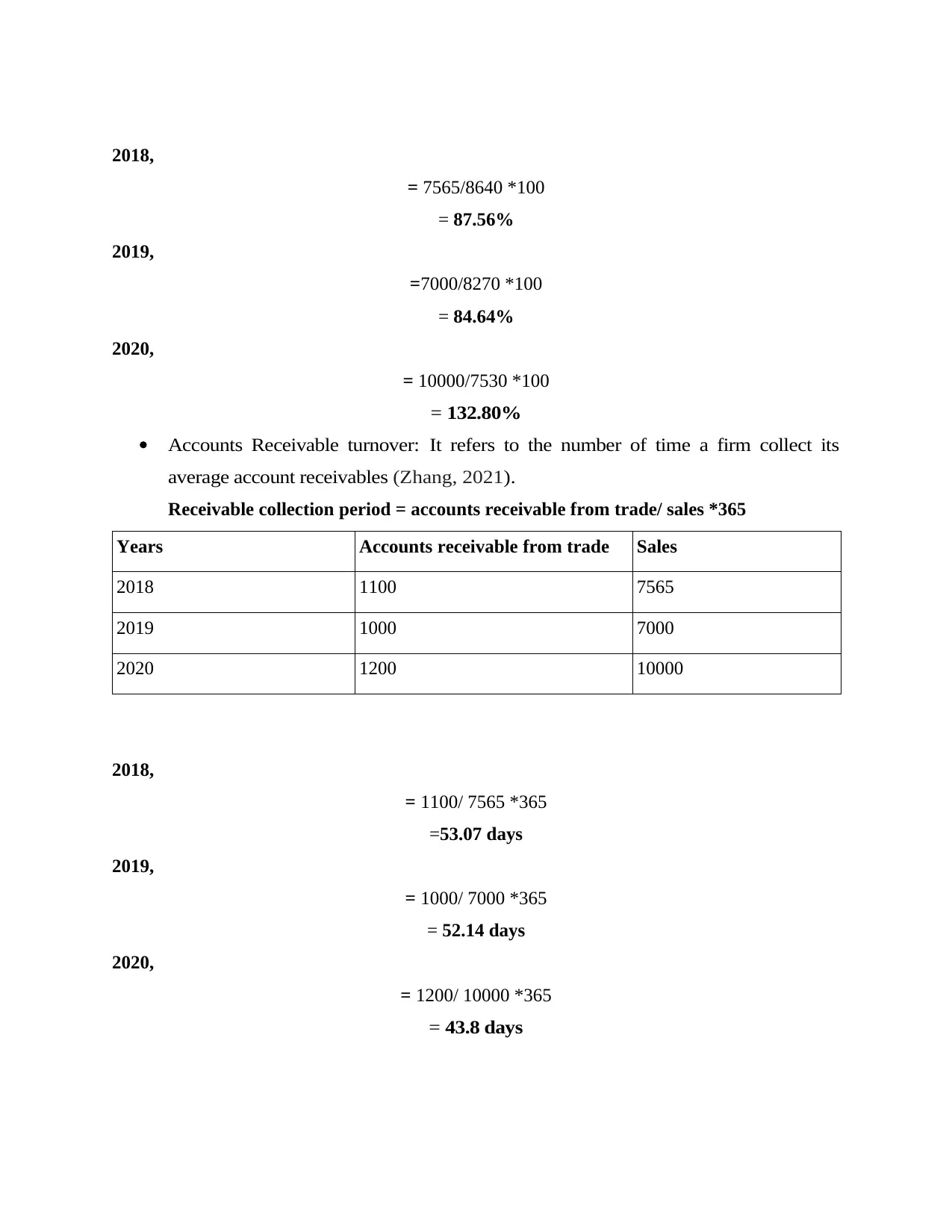
2018,
= 7565/8640 *100
= 87.56%
2019,
=7000/8270 *100
= 84.64%
2020,
= 10000/7530 *100
= 132.80%
Accounts Receivable turnover: It refers to the number of time a firm collect its
average account receivables (Zhang, 2021).
Receivable collection period = accounts receivable from trade/ sales *365
Years Accounts receivable from trade Sales
2018 1100 7565
2019 1000 7000
2020 1200 10000
2018,
= 1100/ 7565 *365
=53.07 days
2019,
= 1000/ 7000 *365
= 52.14 days
2020,
= 1200/ 10000 *365
= 43.8 days
= 7565/8640 *100
= 87.56%
2019,
=7000/8270 *100
= 84.64%
2020,
= 10000/7530 *100
= 132.80%
Accounts Receivable turnover: It refers to the number of time a firm collect its
average account receivables (Zhang, 2021).
Receivable collection period = accounts receivable from trade/ sales *365
Years Accounts receivable from trade Sales
2018 1100 7565
2019 1000 7000
2020 1200 10000
2018,
= 1100/ 7565 *365
=53.07 days
2019,
= 1000/ 7000 *365
= 52.14 days
2020,
= 1200/ 10000 *365
= 43.8 days
⊘ This is a preview!⊘
Do you want full access?
Subscribe today to unlock all pages.

Trusted by 1+ million students worldwide
1 out of 21
Related Documents
Your All-in-One AI-Powered Toolkit for Academic Success.
+13062052269
info@desklib.com
Available 24*7 on WhatsApp / Email
![[object Object]](/_next/static/media/star-bottom.7253800d.svg)
Unlock your academic potential
Copyright © 2020–2025 A2Z Services. All Rights Reserved. Developed and managed by ZUCOL.



